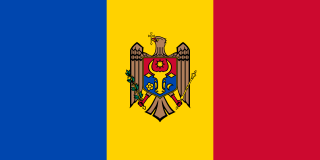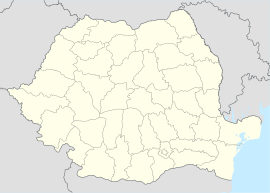
Moldova, officially the Republic of Moldova, is a landlocked country in Eastern Europe. It is bordered by Romania to the west and Ukraine to the north, east, and south. The capital city is Chișinău.

Romania is a country located at the crossroads of Central, Eastern, and Southeastern Europe. It borders with Bulgaria to the south, Ukraine to the north, Hungary to the west, Serbia to the southwest, and Moldova to the east and has its opening to the Black sea. It has a predominantly temperate-continental climate. With a total area of 238,397 square kilometres, Romania is the 12th-largest country in Europe and the 7th most populous member state of the European Union, having approximately 20 million inhabitants. Its capital and largest city is Bucharest. Other major urban areas include: Cluj-Napoca, Timișoara, Iași, Constanța, Craiova, Brașov, and Galați.

Romanian is a Balkan Romance language spoken by approximately 24–26 million people as a native language, primarily in Romania and Moldova, and by another 4 million people as a second language. According to another estimate, there are about 34 million people worldwide who can speak Romanian, out of which 30 million speak it as a native language. It is an official and national language of both Romania and Moldova and is one of the official languages of the European Union.

Transylvania is a historical region that is located in central Romania. Bound on the east and south by its natural borders, the Carpathian mountain range, historical Transylvania extended westward to the Apuseni Mountains. The term sometimes encompasses not only Transylvania proper, but also parts of the historical regions of Crișana and Maramureș, and occasionally the Romanian part of Banat.

Bucharest is the capital and largest city of Romania, as well as its cultural, industrial, and financial centre. It is located in the southeast of the country, at 44°25′57″N26°06′14″E, on the banks of the Dâmbovița River, less than 60 km (37.3 mi) north of the Danube River and the Bulgarian border.

Nicolae Ceaușescu was a Romanian communist politician and leader. He was the general secretary of the Romanian Communist Party from 1965 to 1989 and hence the second and last Communist leader of Romania. He was also the country's head of state from 1967, serving as President of the State Council and from 1974 concurrently as President of the Republic until his overthrow and execution in the Romanian Revolution in December 1989, part of a series of anti-Communist and anti-Soviet Union uprisings in Eastern Europe that year.

Vaslui County is a county (județ) of Romania, in the historical region Western Moldavia, with the seat at Vaslui.

The Kingdom of Romania was a constitutional monarchy that existed in Romania from 26 March 1881 with the crowning of prince Karl of Hohenzollern-Sigmaringen as King Carol I, until 1947 with the abdication of King Michael I of Romania, and the Romanian parliament proclaiming Romania a people's republic.

The Romanians are a Romance ethnic group and nation native to Romania, that share a common Romanian culture, ancestry, and speak the Romanian language, the most widespread spoken Balkan Romance language, which is descended from the Latin language. According to the 2011 Romanian census, just under 89% of Romania's citizens identified themselves as ethnic Romanians.

The Romania national football team represents Romania in international men's football competition, and is administered by the Romanian Football Federation. They are colloquially known as Tricolorii.

Ungureni is a commune in Botoșani County, Western Moldavia, Romania. It is composed of twelve villages: Borzești, Călugăreni, Călugărenii Noi, Durnești, Epureni, Mihai Viteazu, Mândrești, Plopenii Mari, Plopenii Mici, Tăutești, Ungureni and Vicoleni.
The Epureni is a left tributary of the river Mihona in Romania. It flows into the Mihona in the village Epureni. Its length is 10 km (6.2 mi) and its basin size is 24 km2 (9.3 sq mi).
The Iepureni is a left tributary of the river Jijia in Romania. It flows into the Jijia in Iacobeni. Its length is 10 km (6.2 mi) and its basin size is 23 km2 (8.9 sq mi).

The following outline is provided as an overview of and topical guide to Romania:

Duda-Epureni is a commune in Vaslui County, Western Moldavia, Romania. It is composed of four villages: Bobești, Duda, Epureni and Valea Grecului.
Epureni may refer to the following places in Romania:
Cătălin Tănase is a Romanian biologist, professor at the "Alexandru Ioan Cuza" University of Iaşi. He is also director of the "Anastasie Fătu" Botanical Garden of Iaşi. He was elected a correspondent member of the Romanian Academy in 2018.
The 409th Rifle Division was formed as an infantry division of the Red Army, and served in that role for the duration of the Great Patriotic War. It was officially considered an Armenian National division, and initially almost all its personnel were of that nationality. After forming it remained in service along the border with Turkey until nearly the end of 1942, when it was redeployed to the 44th Army in Transcaucasus Front, assisting in driving the German 17th Army into the Kuban peninsula. Following this the division was moved to the 46th Army in Southwestern Front and took part in the summer offensive through the Donbass and eastern Ukraine. In October it was moved again, now to the 57th Army in 2nd Ukrainian Front; it would remain in that Front for the duration of the war, moving to the 7th Guards Army in December. After crossing the Dniepr the 409th won a battle honor in January, 1944, then spent the spring and summer in the battles around Jassy and Kishenev in Moldova. After the defeat of Romania the division advanced into Hungary as part of the 27th Guards Rifle Corps. In October it rejoined the 7th Guards Army, where it remained for the duration, mostly in the 25th Guards Rifle Corps. After the fall of Budapest the division joined the final advances on Vienna and Prague in the spring of 1945, and was disbanded shortly thereafter.

The ongoing COVID-19 pandemic was confirmed to have reached Romania on 26 February 2020, with the first confirmed case in Gorj County.














